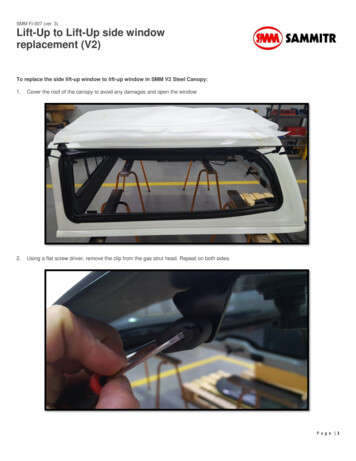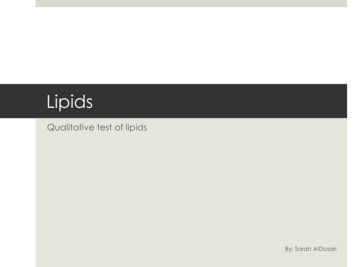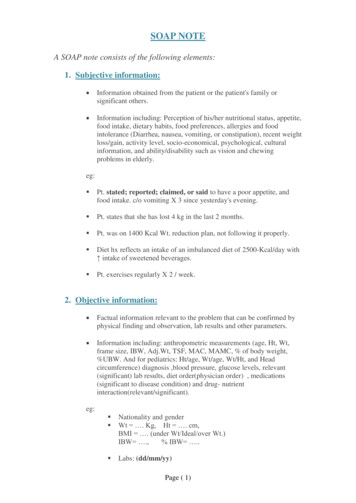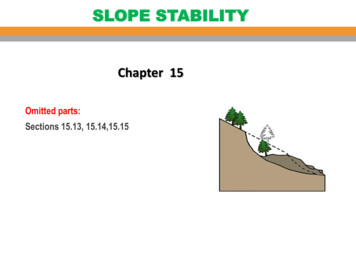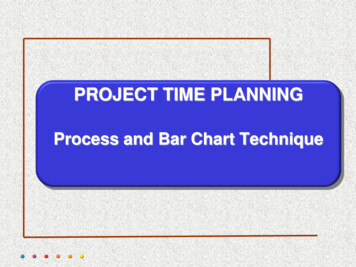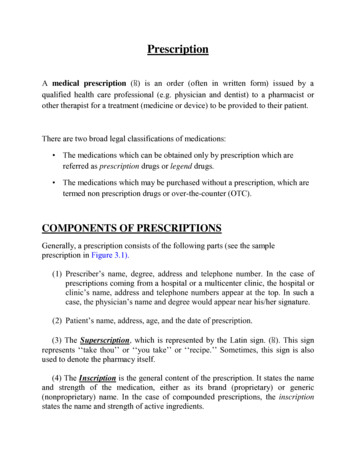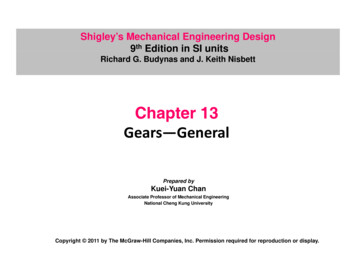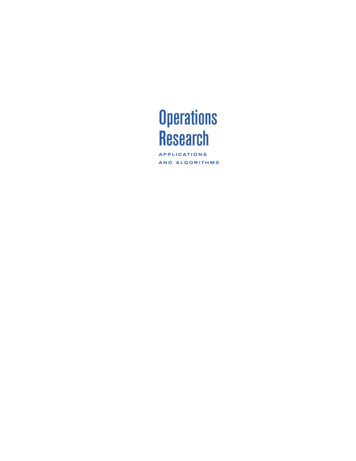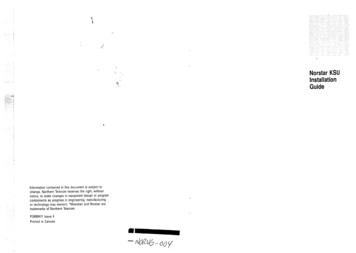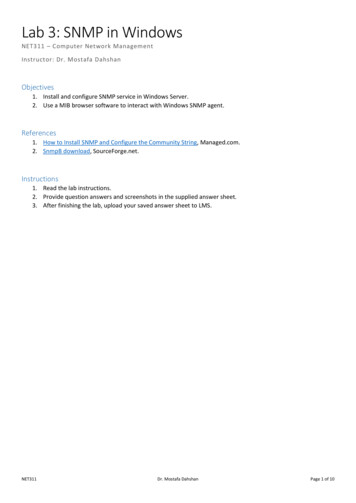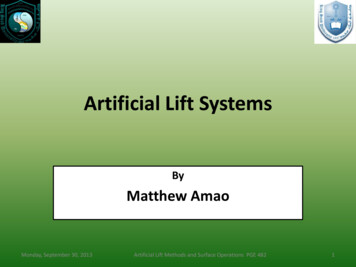
Transcription
Artificial Lift SystemsByMatthew AmaoMonday, September 30, 2013Artificial Lift Methods and Surface Operations PGE 4821
Lecture Outline Artificial Lift Systems–––––––Sucker Rod/Beam PumpingPlunger LiftProgressive Cavity Pump (PCP)Hydraulic PumpElectric Submersible Pump (ESP)Gas LiftFoam Lift Design and Selection Considerations–––––The Reservoir and Well DeliverabilityThe Piping and Artificial Lift SystemEnvironmental ConstraintsOperational ConstraintsEconomicsMonday, September 30, 2013Artificial Lift Methods and Surface Operations PGE 4822
Introduction AL systems are the technologies used to augment fluidproduction from the reservoir. These fall into severalcategories depending on the operating principle, design andenergy source. Production rate from wells may need to beaugmented principally for two reasons;– Inadequate reservoir drive and energy to produce fluid from thereservoir– Non-economic production rate from reservoir’s natural energydrive Aim of Artificial Lift Systems– Reduce the weight of the hydrostatic column on the reservoir, byreducing the density of the fluid column, thereby reducing thedrawdown on the reservoir (𝑝 - 𝑝𝑤𝑓 ), so the formation can give upthe desired reservoir fluid– Add energy to the reservoir fluid for lifting, this also achieves theaim above.Monday, September 30, 2013Artificial Lift Methods and Surface Operations PGE 4823
When Do we Need Artificial Lift?Low Reservoir Pressure/ Production Rate When reservoir pressuredrops and cannotsupport the weight ofcolumn and losses in thelinePreservoir Pline Phydrostatic When economicproduction rates cannotbe achieved by naturaldrive and energy of thereservoir.Monday, September 30, 2013Liquid LoadingWhen the hydrostaticgradient of the liquidcolumn prevents gasfrom coming into thewell in low rate gasand condensatereservoirs.Preservoir PhydrostaticArtificial Lift Methods and Surface Operations PGE 4824
Percentage of Wells on Artificial LiftsMost wells will Need Artificial Lift Sometimes in their Productive LifeMonday, September 30, 2013Artificial Lift Methods and Surface Operations PGE 4825
Operational Classification of PumpsDynamic PumpsPositive Displacement PumpsThese pumps operate by developing a highliquid velocity and converting the velocity topressure in a diffusing flow passage. Theycontinuously impart kinetic energy to thepumped fluid by means of a rotatingimpeller, propeller or rotor.The positive displacement pumpoperates by trapping a fixed amount offluid and forcing the trapped volumeinto the pumps discharge, it alternatelyfills a cavity and then displacing thetrapped volume of liquid. The positivedisplacement pump delivers a constantvolume of liquid for each cycle against avarying discharge pressure or head.A centrifugal pump consists of an impellerwith an intake at its center. Centrifugal pumpinclude radial, axial and mixed flow units.Examples include;Submersible pumpVertical multistage pumpHorizontal multistage pumpMonday, September 30, 2013Examples;Reciprocating pumps- piston, plungerRotary pumps – Progressive cavitypumps (PCP)Artificial Lift Methods and Surface Operations PGE 4826
Operational Classification of PumpsOtherJet or Venturi ersiblePumpAxialRotaryPositiveProgressive CavityPump (PCP)DisplacementReciprocatingMonday, September 30, 2013Sucker Rod/Beam PumpArtificial Lift Methods and Surface Operations PGE 4827
Sucker Rod or Beam Pump(Reciprocating Positive Displacement Pump)In this pump, a down-hole plunger ismoved up and down by a string of rods(sucker rods) connected to an engine atthe surface. The plunger’s movementdisplaces produced fluid into the tubingvia a pump consisting of a combinationof travelling and standing valves locatedin the pump barrel.Monday, September 30, 2013Artificial Lift Methods and Surface Operations PGE 4828
Plunger Lift(Reciprocating Progressive Cavity Pump)LUBRICATORELECTRONICCONTROLLERFLOW TEEW/O-RINGBLEEDBYPASSVALVEMOTORIZEDVALVEVALVEA Typical Plunger CycleMASTERVALVEPlunger Lift is a method of artificial lift thatuses the well’s own energy, either pressureor gas rate, to effectively lift fluids to thesurface. The plunger creates a seal with thetubing wall to reduce the amount ofgas/liquid slippage and lift the fluid tosurface as completely as possibleMonday, September 30, ER SPRINGTUBING STOPArtificial Lift Methods and Surface Operations PGE 4829
Progressive Cavity Pump (PCP)(Rotary Positive Displacement Pump)Helical metal RotorStationary elastomerShape of cavitybetween stator androtor for moving fluidPCP-This pump employs a helical metal rotorrotating inside an elastomeric, double helicalstator. The rotating motion is supplied byeither a downhole electric motor or byrotating rods from an engine at the surface.Monday, September 30, 2013Artificial Lift Methods and Surface Operations PGE 48210
Hydraulic Pump(Dynamic Pump)Hydraulic pumping are in two categories; Hydraulic Piston Pump: This uses highpressure power fluid to drive adownhole turbine pump. Jet Pump: This uses high pressure flowthrough a venturi or jet, creating a lowpressure which produces an increaseddrawdown and inflow from thereservoirMonday, September 30, 2013Artificial Lift Methods and Surface Operations PGE 48211
Electric Submersible Pump (ESP)(A Dynamic Centrifugal Pump)ESP employs a downholecentrifugal pump driven by a threephase electric motor. The electricmotor is powered via an electriccable that runs from the surface,on the outside of the tubing.Monday, September 30, 2013Artificial Lift Methods and Surface Operations PGE 48212
Gas Lift SystemsGas lifts falls in two categories, Continuous and IntermittentGas Lift SystemsIn gas lift, high pressured gas is suppliedto the casing/tubing annulus and the gasis injected into the tubing string throughspecially designed gas valves, positionedin the mandrels on the tubing. Theinjected gas lessens the density of thehydrostatic fluid column.13
Lift Technology By Energy SourceMonday, September 30, 2013Artificial Lift Methods and Surface Operations PGE 48214
Lift Technology By Lift CapacityMonday, September 30, 2013Artificial Lift Methods and Surface Operations PGE 48215
Artificial Lift Market Share by Type Based on Dollars SpentESP- Electrical Submersible PumpRRP Sucker Rod PumpPCP Progressive Cavity PumpMonday, September 30, 2013GL Gas LiftPL Plunger LiftHL Hydraulic LiftArtificial Lift Methods and Surface Operations PGE 48216
Design and Selection ConsiderationsReservoir and WellDeliverabilitySurface Piping andTreatment FacilityDesign straintsEconomicsMonday, September 30, 2013Artificial Lift Methods and Surface Operations PGE 48217
Reservoir and Well Deliverability Reservoir Characteristics Like;– Deliverability of the reservoir-This is the well’s inflow performance(IPR) which represents the ability of the well to produce fluid.– Properties and nature of produced fluids– Liquid Productive Capacity of the Well– Gas Production Expected from the Well– Long term recovery plan Well Characteristics Like;––––––Well Inflow characteristicsFormation depth and dogleg limitations and Effective LiftProduction Casing sizeAnnular and tubing safety systemHole CharacteristicsCompletion TypeMonday, September 30, 2013Artificial Lift Methods and Surface Operations PGE 48218
Location and Environmental Constraints Offshore or Onshore locations- This will determine thespace constraints and what is possible on location, forexample Sucker rod pumps would not be feasibleoffshore. Urban Center or remote locations Climatic and Weather Extremes Distance from wellhead to processing facilities: This isdetermine the design well head pressure. Power source: What power source is available? Diesel,Natural gas, solar etc. to power the ALS.Monday, September 30, 2013Artificial Lift Methods and Surface Operations PGE 48219
Surface Piping and Treatment Facility The surface treatment facility in place wouldaffect the type of ALS to be selected. Thisconsideration on the following;– flow-line,– flow-line restrictions such as chokes, safety valves– separator,– artificial lift mechanismMonday, September 30, 2013Artificial Lift Methods and Surface Operations PGE 48220
Operational Constraints Operating Problems such as solids, formation fines. Some ALS are more tolerant of solidsthan others. Choice of ALS material will depend on the operating conditions of;– Bottom hole temperature,– Corrosive fluids– Extent of solid production– Production rate Automation: Will the system be automated once installed e.g. Intelligent Wells and Smartfields Operating Personnel: Is there capable manpower to run and operate the ALS Service Availability- Availability of ALS maintenance service provider in area. Available Power Source: This will limit the type of engine that the ALS system can have.Monday, September 30, 2013Artificial Lift Methods and Surface Operations PGE 48221
Economics CAPEX (Capital Expense)- This is the initial acquisition andinstallation cost of the ALS. Centralized or standalone system. OPEX (Operating Expense) – This is the cost that would be incurredin the daily running of the ALS. Costs here include, fuel, servicing,replacements parts etc. Its best to choose a system with low OPEX. Personnel Training Costs Repair and Replacement Costs Economy of scale: Number of wells in the field with same systemmay give better project economics. ReliabilityMonday, September 30, 2013Artificial Lift Methods and Surface Operations PGE 48222
Long Term Reservoir Performance andFacility Constraints Production engineers are sometimes faced with thequestion; how big a ALS should I design for? Should Idesign for immediate production or design for futureproduction rates. An ALS can be under-designed oroverdesigned for fluid and well conditions. Hence a good projection of future production profilemust be taken into considerations when carrying out aALS design.Monday, September 30, 2013Artificial Lift Methods and Surface Operations PGE 48223
A Comparison Table Showing the RelativeStrength of Artificial Lift SystemsMonday, September 30, 2013Artificial Lift Methods and Surface Operations PGE 48224
A Comparison Table Showing the RelativeStrength of Artificial Lift SystemsMonday, September 30, 2013Artificial Lift Methods and Surface Operations PGE 48225
Monday, September 30, 2013Artificial Lift Methods and SurfaceOperations PGE 48226
Monday, September 30, 2013Artificial Lift Methods and SurfaceOperations PGE 48227
References James F. Lea and Henry V. Nicken, “Selection of Artificial Lift”,SPE 52157 Heriot Watt University, Production Technology Course Notes Wikepeadia, www.wikipedia.orgMonday, September 30, 2013Artificial Lift Methods and Surface Operations PGE 48228
Artificial Lift SystemsByMatthew AmaoMonday, September 30, 2013Artificial Lift Methods and Surface Operations PGE 48229
Pump (PCP) Sucker Rod/Beam Pump . Monday, September 30, 2013 Artificial Lift Methods and Surface Operations PGE 482 8 Sucker Rod or Beam Pump (Reciprocating Positive Displacement Pump) In this pump, a down-hole plunger is moved up and down by a string of rods (sucker rods) connected to an engine at the surface. The plunger’s movement displaces produced fluid into the tubing via a pump .
